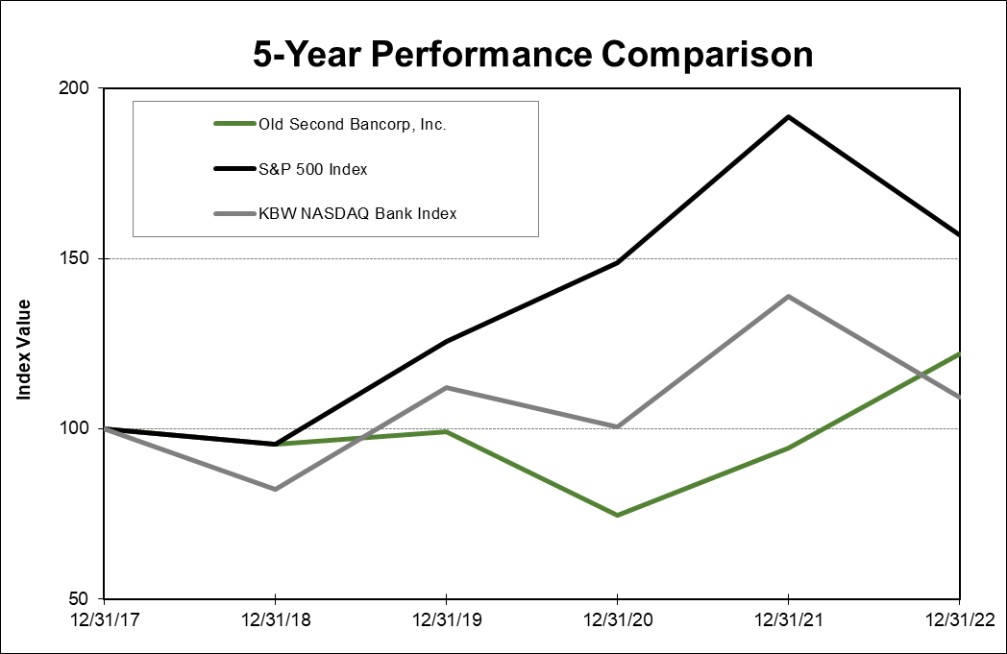Market Area
Our main office is located at 37 South River Street, Aurora, Illinois 60507. The city of Aurora is located in northeastern Illinois, approximately 40 miles west of Chicago. The Bank operates primarily in Cook, DeKalb, DuPage, Kane, Kendall, LaSalle, and Will counties in Illinois, and it has developed a strong presence in these counties. The Bank offers its services to retail, commercial, industrial, and public entity customers in the Aurora, Bartlett, Batavia, Bensenville, Bloomingdale, Bolingbrook, Burlington, Carol Stream, Chicago, Chicago Heights, Darien, Downers Grove, Elburn, Elgin, Frankfort, Glendale Heights, Joliet, Kaneville, Lombard, Montgomery, Naperville, North Aurora, Oakbrook Terrace, Oswego, Ottawa, Plano, Romeoville, South Elgin, St. Charles, Sugar Grove, Sycamore, Villa Park, Warrenville, Wasco, Wheaton, and Yorkville communities and surrounding areas through its 48 banking locations that are located primarily in the western and southern portions of the Chicago metropolitan area.
Lending Activities
We provide a broad range of commercial and retail lending services to corporations, partnerships, individuals and government agencies. We market our services to qualified borrowers, and our lending officers actively solicit the business of new borrowers entering our market areas as well as long-standing members of the local business community. We have established lending policies that include a number of underwriting factors to be considered in making a loan, including location, amortization, loan to value ratio, cash flow, leverage, pricing, documentation and the credit history of the borrower. In 2022, our total loan portfolio grew $448.8 million year over year. We had approximately $1.9 billion in loan originations, excluding renewals, in 2022. We originated approximately $134.5 million of residential mortgage loans in 2022, which includes originations of loans held for sale of $76.6 million. Proceeds from the sales of residential mortgage loans to third parties were $81.8 million in 2022.
Our loan portfolio is comprised of loans in the areas of commercial real estate, residential real estate, general commercial, construction real estate, leases, and consumer lending. As of December 31, 2022, commercial real estate loans represented approximately 47.6% (44.8% at year-end 2021) of our loan portfolio, residential mortgages represented approximately 15.5% (17.1% at year-end 2021), general commercial loans represented approximately 21.7% (22.5% at year-end 2021), home equity lines of credit represented approximately 2.8% (3.7% at year-end 2021), construction lending represented approximately 4.7% (6.0% at year-end 2021), leases represented approximately 7.2% (5.1% at year-end 2021), and consumer and other lending represented less than 1.0% (less than 1.0% at year-end 2021). It is our policy to comply at all times with the various consumer protection laws and regulations including, but not limited to, the Equal Credit Opportunity Act, the Fair Housing Act, the Community Reinvestment Act, the Truth in Lending Act, and the Home Mortgage Disclosure Act.
Commercial Loans. We continue to focus on identifying commercial and industrial prospects in our new business pipeline, which led to favorable results in 2022. As noted above, we are an active commercial lender in the Chicago metropolitan area, with primary markets in the city of Chicago, as well as west and south of Chicago. In late 2021, we continued to grow our commercial lending team with the addition of a sponsor finance team, which grew their line of business throughout 2022, focusing on lower middle market private equity-backed businesses. Commercial lending is comprised of revolving lines of credit for working capital, lending for capital expenditures on manufacturing equipment and lending to small business manufacturers, service companies, medical and dental entities as well as specialty contractors. We also have commercial and industrial loans to customers in food product manufacturing, food process and packing, machinery tooling manufacturing, healthcare, as well as service and technology companies. Collateral for these loans generally includes accounts receivable, inventory, equipment and real estate. In addition, we often obtain personal guarantees to help assure repayment. Loans may be made on an unsecured basis if warranted by the overall financial condition of the borrower. Commercial term loans range principally from one to seven years with the majority falling in the one to five year range. Interest rates on commercial loans are a mixture of fixed and variable rates, with these rates often tied to the prime rate, a spread over the FHLB Chicago index rate, a Treasury constant maturity index, LIBOR, as well as SOFR.
Repayment of commercial loans is largely dependent upon the cash flows generated by the operations of the commercial borrower. Our underwriting procedures identify the sources of those cash flows and seek to match the repayment terms of the commercial loans to those sources. Secondary and tertiary repayment sources are typically found in collateralization and guarantor support.
Lease Financing Receivables. We continued growth of our lease portfolio in 2022 with organic lease originations. The collateral for lease financing receivables primarily includes construction and transportation equipment, and lease terms typically range from one to seven years, with the majority falling in the one to five year range. Growth in this portfolio reflects management’s efforts to diversify lending product offerings, and lessen our commercial real estate loan concentration.
Commercial Real Estate Loans. The composition of the loan portfolio remains weighted towards commercial real estate at 47.6% for 2022 compared to 44.8% in 2021. Management continues to monitor concentrations so that we remain comfortable with our position in real estate loans. As of December 31, 2022, approximately $854.9 million, or 46.4% (47.8%, at year-end 2021) of the total commercial real estate loan portfolio of $1.84 billion consisted of loans to borrowers secured by owner occupied property. A primary repayment risk for owner occupied commercial real estate loans is a reduction of or discontinuance of cash flows from underlying operations; for non-owner occupied loans, cash flow disruptions may occur with the loss of a tenant or rental income reductions. Repayment could also be influenced by economic events, which may or may not be under the control of the borrower, or changes in regulations that negatively

